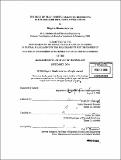| dc.contributor.advisor | Robert C. O'Handley and Samuel M. Allen. | en_US |
| dc.contributor.author | Méndez de la Luz, Diego A., 1979- | en_US |
| dc.contributor.other | Massachusetts Institute of Technology. Dept. of Materials Science and Engineering. | en_US |
| dc.date.accessioned | 2005-09-27T18:48:19Z | |
| dc.date.available | 2005-09-27T18:48:19Z | |
| dc.date.copyright | 2004 | en_US |
| dc.date.issued | 2004 | en_US |
| dc.identifier.uri | http://hdl.handle.net/1721.1/28872 | |
| dc.description | Thesis (M. Eng.)--Massachusetts Institute of Technology, Dept. of Materials Science and Engineering, 2004. | en_US |
| dc.description | Includes bibliographical references. | en_US |
| dc.description.abstract | (cont.) portable consumer electronics, such as PDAs, cell phones, music players, digital cameras, etc. make a relatively modest but fast growing market for ultrahigh areal density HAMR-based HDDs. HAMR-based HDD for portable applications could very well be a disruptive technology in the magnetic recording industry. Companies that intend to profit from this technology need to invest on its development and must try to be first-to-volume production to benefit from economies of scale and to build the necessary expertise that could give them leadership roles in future magnetic recording. | en_US |
| dc.description.abstract | The magnetic recording industry keeps up with the demand of high capacity hard disk drives by improving the areal recording density of these devices. The use of conventional longitudinally magnetized media will be truncated by the challenges it faces nowadays, which are related to the instability of the stored information, produced by the aggressive decrease in the volume of the grains in the media. To overcome this problem, the use of large magnetic anisotropy energy density alloys is necessary, but the write fields that are required by such alloys can be prohibitively large, rendering these media effectively unwritable. Fortunately, the magnetocrystalline anisotropy energy density decreases with increasing temperature and so does the required write field. Heat assisted magnetic recording allows the use of such magnetically hard alloys by using both a magnetic and a thermal field during the writing process. Research in HAMR is centered in three major fields: the heat delivery system, the magnetic recording media and the heat dissipation technology. Based on an analysis of several US patents related to HAMR, one can see the real value of such patents is in negotiating and cross-licensing between companies to guarantee the right to participate in the manufacture of HDDs. Trade secrets and know-how are valuable assets for corporations. However, information exchange exists due to the great mobility of highly trained personnel between competing companies. Because the basic application of HAMR is in supplying the computer industry with affordable storage devices, there is a well established market that makes the research efforts in HAMR advisable for individuals, universities and companies. Besides that traditional market, | en_US |
| dc.description.statementofresponsibility | by Diego A. Méndez del la Luz. | en_US |
| dc.format.extent | 70 leaves | en_US |
| dc.format.extent | 4175342 bytes | |
| dc.format.extent | 4182241 bytes | |
| dc.format.mimetype | application/pdf | |
| dc.format.mimetype | application/pdf | |
| dc.language.iso | en_US | |
| dc.publisher | Massachusetts Institute of Technology | en_US |
| dc.rights | M.I.T. theses are protected by copyright. They may be viewed from this source for any purpose, but reproduction or distribution in any format is prohibited without written permission. See provided URL for inquiries about permission. | en_US |
| dc.rights.uri | http://dspace.mit.edu/handle/1721.1/7582 | |
| dc.subject | Materials Science and Engineering. | en_US |
| dc.title | The role of heat assisted magnetic recording in future hard disk drive applications | en_US |
| dc.type | Thesis | en_US |
| dc.description.degree | M.Eng. | en_US |
| dc.contributor.department | Massachusetts Institute of Technology. Department of Materials Science and Engineering | |
| dc.identifier.oclc | 60425345 | en_US |
